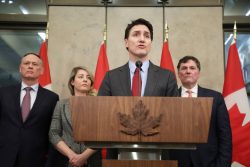WASHINGTON, (Reuters) – U.S. employment increased strongly in March, underscoring the economy’s resilience, but an influx of Americans into the labour market could temper nascent wage growth and keep the Federal Reserve cautious about further interest rate increases. Nonfarm payrolls rose by 215,000 last month and the unemployment rate edged up to 5.0 percent from an eight-year low of 4.9 percent, the Labour Department said on Friday. The jobless rate increased as more people continued to enter or re-enter the labour market, a sign of confidence in the job market.
Average hourly earnings gained seven cents after slipping in February. The labour market has largely shrugged off slowing global economic growth, a robust U.S. dollar that has hurt manufacturing exports and the drag on energy sector profits from cheap oil.
Economists see a limited impact on monetary policy in the near-term from the strong jobs report, as the growing number of people entering the labor market supported Fed Chair Janet Yellen’s view that hidden slack remained in the jobs market.
“This is an ideal situation for the Fed. The strong pace of job growth is being offset by the increase in entrants into the labor force, which will reduce any concerns about labor market tightness fostering outsized wage inflation,” said Millan Mulraine, deputy chief economist at TD Securities in New York.
The Fed also appears to be more focused on international developments. Yellen said this week that slowing world growth and lower oil prices posed a downside risk to the U.S. economic outlook, adding that she considered it appropriate for policymakers to “proceed cautiously in adjusting policy.”
Fed officials last month downgraded their economic growth expectations and forecast only two rate hikes this year. The U.S. central bank raised its benchmark overnight interest rate in December for the first time in nearly a decade.
Financial markets see a 27 percent chance of a hike at the Fed’s June policy meeting, a 52 percent chance of such a move in September and a 65 percent probability at the December meeting, according to CME FedWatch. Economists polled by Reuters had forecast nonfarm payrolls increasing 205,000 in March and the unemployment rate holding steady at 4.9 percent. The economy created 1,000 fewer jobs in January and February than previously reported.
Prices for longer-dated U.S. government bonds initially fell after the data, but later marginally rose. The dollar gave up earlier gains against a basket of currencies, while U.S. stocks ended higher.








